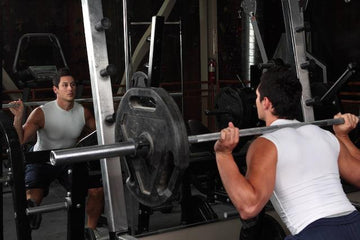

Earthquake Bar Bench Press: Shake Your Way to More Mass
Table of Contents
In recent years, there have been several accessories added to the weight room that can make the gym more enjoyable such as using bands and chains have been reported to result in greater increases in muscle strength. Bands and chain training is a form of variable resistance exercise. For example, the barbell squat, the weight of the bar stays the same throughout the lift. Variable resistance such as bands and chains requires differing degrees of force to be applied to the target muscle to create constant resistance, compelling the muscle to work harder to meet the demands of the exercise. For example, with bands and chains, the force to require the bar to be lifted is much greater than standard resistance exercise as each chain is lifted off the floor or the band is stretched.
Squat Bands
Chain Bench Press
A previous study found that replacing some of the free weight resistance with elastic band resistance during bench press training resulted in greater increases in strength over a 13-week training period compared to bench pressing with traditional fixed resistance. In a recent meta-analysis, when researchers examined the effects of a long-term (≥ seven weeks) variable resistance training program using chains or elastic bands, it was found that variable resistance training led to a significantly greater mean strength gain than the gain recorded in response to conventional weight training. So based on this meta-analysis of studies, if you are looking to increase your bench press or squat, be sure to incorporate band and chain training into your regimen.
Shake your Way to a Stronger Bench Press
The Earthquake Bar was specially designed to hold a significant amount of weight and can be set up in a multitude of ways with bands and weights. Instead of safety slots, it has two-inch grooves cut into the wood to channel and grip the bands as the Bar bends radically under super-heavy weight. If you have ever seen someone uses one of these bars, they tend to shake because of the instability of the bar.
It has been assumed that training with instability such as the earthquake bar and the bamboo bar results in higher activation of the stabilizing muscles and is more beneficial to sports performance. One of the disadvantages of instability training is that you have to use a much lighter weight to stabilize your body. Furthermore, many studies have shown that peak force output is lower when training on an unstable surface. For example performing a chest press on an unstable surface resulted in a 59.6% decrease in maximal isometric force production compared to the stable condition. Little is known about the effects of the earthquake bar on muscle activation.
The great thing about the study was that the researchers reported that when using an Earthquake bar, the activation of the prime movers in the bench press was similar, while activation of some stabilizing muscles was greater in comparison with a stable load, even though the absolute weight was lower when using the unstable load. In short, the lifters were using a lighter weight but getting the same muscle activation of the chest as using a heavier weight. The Earthquake bar also took longer to press (increased duration of the concentric and eccentric phases) as compared to the stable load. An unbalanced load will also increase the time under tension, which may lead to different training effects.
Key Points: The Earthquake Bar was able to activate similar muscle activation despite using a lighter weight. Using the Earthquake Bar can be a great way to add variety to your workout despite using a lower amount of weight.


















